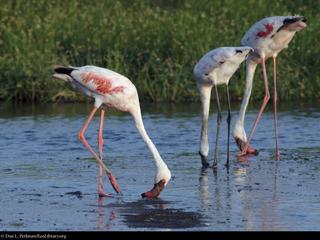Human civilization has seen species getting extinct from the planet. In some cases their greed and modernization worked as catalyst to the disappearance of the creatures. Now it is the time of flamingos. The colossal gathering of flamingos in East Africa is directly under threat by aggressive industrial development. May be this is the end of the flamingos. Conservationists signal high alarm on the matter.

Half a million bright pink lesser flamingos select the Lake Natron in Tanzania as their breeding habitat. Recently there have been activities around Lake Natron, which has seen a development of Lake Natron Resources Limited, part of the Indian organization Tata Chemicals, to pump salty water from the lake to produce sodium carbonate or washing soda.
This entire venture requires a coal fired power station and to house more than 1,000 on site construction staff on site. As a result, the flamingos are facing severe problems due to the natural imbalance created with the soda ash plant on its shores.
Conservationists have started breathing fire against this plant. Dr Chris Magin, international officer for Africa for the Royal Society for the Protection of Birds said
Putting Lake Natron at risk is bonkers. It is a pristine site, like no other in the world. The chances of lesser flamingos continuing to breed at Lake Natron in the face of such mayhem are next to zero. This development will leave lesser flamingos in east Africa facing extinction and should be stopped in its tracks and sunk in water so deep it can never be revived
Lake Natron is situated in the Great Rift Valley in northern side of Tanzania. This lake is mainly known as Soda Lake because of its high concentration of sodium carbonate. This site is one of the only five breeding points for lesser flamingos in the world.
Lake Natron, which is in the Great Rift Valley in northern Tanzania, and is known as a soda lake because of its high concentration of sodium carbonate, is one of only five breeding sites for lesser flamingos in the world, but if it is damaged, there is no evidence that the birds will breed successfully elsewhere.
This lake hosts around 500,000 lesser flamingos during summer, which is around 75% of the total population. It has been the bird’s only nesting site in East Africa for last 45 years. Reasonably this lake is listed by the International Ramsar Wetland Convention and designated an Important Bird Area by BirdLife International.
Flamingos live for around 40 years but they breed every five or six years. Birds not breeding do not come to the breeding place until they are prepared to breed again. So there is a possibility that if Lake Natron is damaged, there is a chance that the lesser flamingos will not successfully breed anywhere else.
In words of Dr Magin,
This could be the beginning of the end for the lesser flamingo. Millions of people have enjoyed the spectacle of flocks of flamingos in Tanzania and Kenya and all of that is now in jeopardy
Source: The Independent
Image

